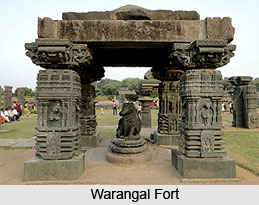 Early History of Telangana is the golden age of Indian history. This period covers the glorious rule of Satavahana dynasty, Kakatiyas, Chalukyas, Cholas and many others. All the dynasties showed their excellence in art, literature and sculpture.
Early History of Telangana is the golden age of Indian history. This period covers the glorious rule of Satavahana dynasty, Kakatiyas, Chalukyas, Cholas and many others. All the dynasties showed their excellence in art, literature and sculpture.
Telangana was ruled in ancient times by the rulers of Satavahana Dynasty. At that time, Pothan (now called Bodhan) was the capital of Assakajanapada, considered one of the ruling kingdoms of sixteen great Janapadas of early India, which was known Shorosha Mahajanapadas.
Satavahana dynasty ruled the area of Telangana from 230 BC to 220 BC. The kings of Satavahana dynasty became the dominant power in the area. It originated from the lands between the Godavari River and Krishna River. After the decline of the Satavahanas, various dynasties, such as the Vakataka dynasty, Vishnukundina dynasty, Chalukya dynasty, Rashtrakuta dynasty and Western Chalukya dynasty ruled the area of Telangana.
After the decline Satavahana Dynasty, Kakatiyas came into the power. The Kakatiya dynasty rulers built the Toranas in Warangal in the year 1163AD. During the period of Kakatiya rule the Ramappa Temple was built in 1213 by ruler Recherla Rudra of Kakatiyas.
From the year 1083 to 1323, Telangana experienced the golden age during the reign of the Kakatiya dynasty. The rulers of Kakatiya dynasty ruled most of the parts of Andhra Pradesh and Telangana. Ganapatideva, one of the prominent rulers of Kakatiya Dynasty came to power in 1199. He was known as the greatest of the Kakatiyas. He was the first after the Satavahanas to bring the entire Telugu area under one rule. He put an end to the rule of the Telugu Cholas, who accepted his suzerainty in the year 1210. He established order in his vast dominion that stretched from the Godavari delta in the east to Raichur (in modern day Karnataka) in the west and from Karimnagar and Bastar (in modern day Chhattisgarh) in the north to Srisailam and Tripurantakam, near Ongole, in the south. It was during his reign that the Golkonda fort was constructed. Rudrama Devi and Prataparudra were prominent rulers from the Kakatiya dynasty. The dynasty weakened with the attack of Malik Kafur in 1309 and was dissolved with the defeat of Prataparudra by the forces of Muhammad bin Tughluq in 1323.



















